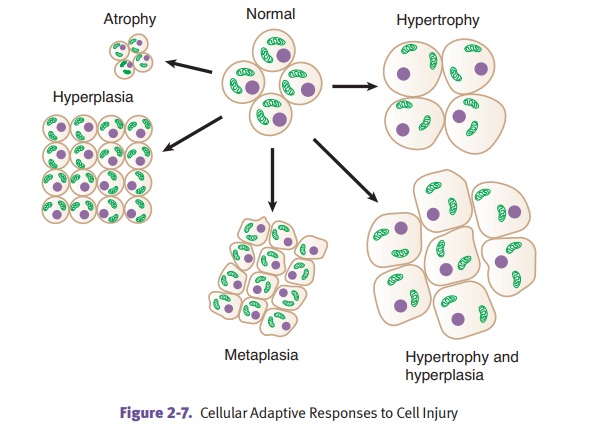Chapter: Pathology: Cellular Injury and Adaptation
Cellular Adaptive Responses to Injury

CELLULAR ADAPTIVE RESPONSES TO INJURY
In
general, cellular adaptation is a potentially reversible change in response to
the environment.

Atrophy is
a decrease in cell/organ size and functional ability. Causes of atrophyinclude
decreased workload/disuse (immobilization); ischemia (atherosclerosis); lack of
hormonal or neural stimulation, malnutrition, and aging.
Light
microscopic examination shows small shrunken cells with lipofuscin granules.
Electron microscopy shows decreased intracellular components and
autophagosomes.
Hypertrophy
is an increase in cell size and functional ability due to
increased syn-thesis of intracellular components.
Causes
of hypertrophy include:
·
Increased mechanical demand can be
physiologic (striated muscle of weight lifters) or pathologic (cardiac muscle
in hypertension).
·
Increased endocrine stimulation
plays a role in puberty (growth hormone, androgens/estrogens, etc.), gravid
uterus (estrogen), and lactating breast (pro-lactin and estrogen).
Hypertrophy
is mediated by growth factors, cytokines, and other trophic stimuli and leads
to increased expression of genes and increased protein synthesis.
Hypertrophy
and hyperplasia often occur together.
Hyperplasia
is an increase in the number of cells in a tissue or organ.
Some celltypes are unable to exhibit hyperplasia (e.g., nerve, cardiac,
skeletal muscle cells).
·
Physiologic causes of hyperplasia include
compensatory mechanisms (e.g., after partial hepatectomy), hormonal stimulation
(e.g., breast development at puberty), and antigenic stimulation (e.g.,
lymphoid hyperplasia).
·
Pathologic causes of hyperplasia
include endometrial hyperplasia and pros-tatic hyperplasia of aging.
Hyperplasia
is mediated by growth factors, cytokines, and other trophic stimuli; increased
expression of growth-promoting genes (proto-oncogenes); and increased DNA
synthesis and cell division.
Metaplasia
is a reversible change of one fully differentiated cell type
to another,usually in response to irritation. It has been suggested that the
replacement cell is better able to tolerate the environmental stresses. For
example, bronchial epithelium undergoes squamous metaplasia in response to the
chronic irritation of tobacco smoke.
The
proposed mechanism is that the reserve cells (or stem cells) of the irritated
tissue differentiate into a more protective cell type due to the influence of
growth factors, cytokines, and matrix components.
Related Topics